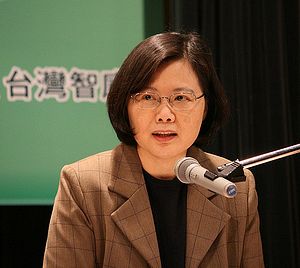In an annual meeting of officials in charge of Taiwan affairs, Yu Zhengsheng, chairman of the National Committee of the Chinese People’s Political Consultative Conference, delivered some remarks on Beijing’s Taiwan policy agenda for 2016. To push forward the peaceful development of cross-strait relations, Beijing will continue to adhere to the one-China principle, firmly opposes any form of secessionist activities seeking Taiwan independence, and resolutely safeguards national sovereignty and territorial integrity. As Taiwan President-elect Tsai Ing-wen and her traditionally pro-independence Democratic Progressive Party (DPP) still decline to accept the one-China principle, the future of cross-strait relations is fraught with uncertainties. If an active acceptance of the one-China principle is not in Tsai’s makeup, will a passive “non-denial” of the principle work in a new Beijing-Taipei relationship?
Beijing’s Concerns
It is worth noting that this is the first time in the past three years that Yu included the one-China principle in his annual speech. Before this year, instead of directly citing the principle, Yu emphasized the importance of adhering to the “1992 Consensus,” a verbal agreement between Taiwan’s Kuomintang (KMT) and the Communist Party of China (CPC) to keep the concept of “one China” but allow strategic uncertainty surrounding its precise definition to maintain cross-strait ties. The particular inclusion of the one-China principle this year signals that Beijing is worried about Tsai’s recent attempts to reinterpret the Consensus, and intends to clarify that the one-China principle is the essence of the Consensus. To assure the Taiwan public that she can manage the relations with Beijing, Tsai has recently begun to express her views on the Consensus rather than eschew the whole concept entirely. She argued that she does not deny the “historical fact” of the cross-strait dialogues in 1992 and that she hopes to return to the “original spirit of setting aside differences to seek common grounds that formed the basis of the 1992 cross-strait meetings.” Yu’s speech, however, sends a message to Tsai: What matters is not the phraseology of the 1992 Consensus, but the core of the Consensus, the one-China principle.
Surprisingly, while Beijing is not satisfied with Tsai’s interpretation of the Consensus, it is not intensely pressuring Tsai to accept the one-China principle as a condition of continued cross-strait exchanges. One explanation is that Beijing is still waiting to see what changes occur in Tsai’s cross-strait policy before Tsai assumes office on May 20. A strong reaction would be premature.
Another explanation is that Beijing might have noticed that with the current domestic atmosphere unfriendly toward Beijing, Tsai is unlikely to accept the one-China principle. To agree to the principle, Tsai will be facing pressure both from the Taiwan public and her political party. A polling result has shown that since 2007 identity as “Taiwanese” has ranked first among all options –including choices of “Chinese” and “both Taiwanese and Chinese.” This growing Taiwanese consciousness makes it less likely that people in Taiwan, particularly the younger generation, will uphold a concept that the two sides of the Taiwan Strait belong to one China. Within Tsai’s party, DPP’s 1999 Resolution on Taiwan’s Future, which Tsai has confirmed as the party guidelines today, indicated that Taiwan should “renounce the ‘one China’ position.” This wording fundamentally contradicts Beijing’s one-China principle. The other explanation is that it is in Beijing’s interests to continue adopting policy approaches to engage with people in Taiwan to win the hearts and minds of the Taiwanese people. In his speech this year, Yu stressed that Beijing will seek to facilitate exchanges in culture, education, tourism and religion and promote economic integration to “benefit as many small businesses, farmers and fishermen as possible.” Beijing believes that a deepening relationship with people in Taiwan would improve the understanding between the two sides of the Taiwan Strait, and will further reverse any negative impression of Mainland Chinese in Taiwan society. In its most recent effort, Beijing has announced to donate five million yuan to Taiwan’s Red Cross Society through its Association for Relations Across the Taiwan Straits (ARATS) for earthquake recovery and relief efforts in Taiwan.
A Non-Denial Formula
If an active acceptance of the one-China principle is nigh on impossible for Tsai Ing-wen, would a passive non-denial of the one-China principle work for Beijing and Tsai? In fact, Tsai has gradually taken small steps to show that her cross-strait policy is compatible with what Beijing wants. Although she does not advocate the one-China concept, Tsai has signaled that her administration will promote the peaceful and stable development of cross-strait relations based on an “existing political foundation,” which contains “the existing Republic of China (ROC) constitutional order.”
In its latest response to Tsai’s cross-strait policy, Beijing said nothing new but simply reiterated the one-China principle, “the fact that the Mainland and Taiwan belong to one China has never changed, and will not change.” Indeed, Beijing’s repeatedly mentioning the one-China principle has made it clear that the new Taiwan government has little choice but to address the principle. After all, cross-strait relations have been developed based on the one-China principle for the past seven years, and it is hardly likely that Beijing will accept a step backwards from its hope to achieve the national reunification with Taiwan. While Beijing may show some flexibility in accommodating a temporary policy of non-denial of the one-China principle temporarily, it is unclear when Beijing’s patience will run out.
Emily S. Chen is a Silas Palmer Fellow with the Hoover Institution, a Young Leader with the Pacific Forum CSIS, and a Non-Resident Fellow with the Center for the National Interest. She holds a Master’s degree in East Asian Studies and a focus on international relations at Stanford University. Emily tweets @emilyshchen.































